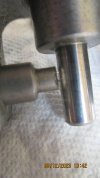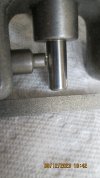Costs would go up exponentially with much more machine timeIntegral recoil lug and pic rail would have been a sweet option. CRF and mechanical ejector too. LOL
-
If you are being asked to change your password, and unsure how to do it, follow these instructions. Click here
You are using an out of date browser. It may not display this or other websites correctly.
You should upgrade or use an alternative browser.
You should upgrade or use an alternative browser.
I’m Turning Necks Now!
- Thread starter DoneNOut
- Start date
 Help Support Long Range Hunting Forum
Help Support Long Range Hunting Forum
DoneNOut
Well-Known Member
I have 3 actions with those features and their cost is only $100-150 more per unit. W though, I agree, would certainly jack the price more.Costs would go up exponentially with much more machine time
6fatrat
Well-Known Member
This is where i take mine as well.
That is beautiful!This is where i take mine as well.
I turn mine at 30 cal, neck down, then clean up cut. It takes quite a few firings before the doughnuts show up in the cases with the softest Rockwell hardness.
I like .005 clearance on a loaded round for good bullet release.
Hugnot
Well-Known Member
I have been using this setup for many years and have turned 1,000's of case necks.





This is real old RCBS neck turner. The tiny little Allen head set screws holding the pilot were replaced by larger hex bolts (drill & tap aluminum turner body - ugly), the cutter blade is periodically sharpened & cutting angles maintained by the diamond faced file shown, a Hastings Triplet 10X magnifier is used to check out cutter edges & corners, the Dewalt cordless turns brass of .473 head size and smaller directly chucked into cordless.
Three 6.5-06 samples are shown: top -- loaded 6.5-06 with 130 H ELDM (.30-06 necked down), turned to .287, neck wall .013 -- middle - unfired 6.5-06 case (reformed .30-06) -- bottom fired 6.5 - 06 case. This brass is once fired .30-06, Hornady nickel plated, from Once Fired Brass, it was annealed after forming to 6.5-06.
Pics of cutter and pilot and diamond file.
Tuning necks to .290 (seated bullet) give .003 - .004 clearance in chamber giving nice slip fit of .264 bullet into fired case. Brass is annealed every 4 firings and bullets have light crimp with a Lee .264 Win Mag factory crimp die. Bullets are selected to avoid donut formed at shoulder neck - nice slip fit throughout brass life.





This is real old RCBS neck turner. The tiny little Allen head set screws holding the pilot were replaced by larger hex bolts (drill & tap aluminum turner body - ugly), the cutter blade is periodically sharpened & cutting angles maintained by the diamond faced file shown, a Hastings Triplet 10X magnifier is used to check out cutter edges & corners, the Dewalt cordless turns brass of .473 head size and smaller directly chucked into cordless.
Three 6.5-06 samples are shown: top -- loaded 6.5-06 with 130 H ELDM (.30-06 necked down), turned to .287, neck wall .013 -- middle - unfired 6.5-06 case (reformed .30-06) -- bottom fired 6.5 - 06 case. This brass is once fired .30-06, Hornady nickel plated, from Once Fired Brass, it was annealed after forming to 6.5-06.
Pics of cutter and pilot and diamond file.
Tuning necks to .290 (seated bullet) give .003 - .004 clearance in chamber giving nice slip fit of .264 bullet into fired case. Brass is annealed every 4 firings and bullets have light crimp with a Lee .264 Win Mag factory crimp die. Bullets are selected to avoid donut formed at shoulder neck - nice slip fit throughout brass life.
Last edited:
Mike Matteson
Well-Known Member
You are right on!Yes he does !
Now you have another problem, Cartridge overall length vs mag box length.
Of course, if you spec a reamer out as Beluebo mentions(as many do), there is always the thinking that you can find a bug hole node with the bullet jumping a country mile. Then you are forced to talk yourself into accepting that 1/2" accuracy at 100 yards, at least for a while when the barrel is new.
I have over 50-60 reamers, never counted, along with uni throaters.
Thinking has sure changed over the years on reamer design, in many ways with some good and some not too good. Selling and marketing have to always go with what the popular thinking is of the time.
Think about it, how many reloaders/shooters go to the lengths that Gingerman has gone to in educating himself and purchasing the necessary equipment to accomplish his accuracy goals? Many have learned from the experience he has shared here on this board!
As Beluebow has suggested in his reamer design, the next logical step for Gingerman and others is to realize that a Long action is a logical conclusion, but how popular is that? Long actions while practical but NOT popular, that extra 6 oz of the weight of a long action/stock is a deal killer for many. Beluebow's reamer design is THE accepted way of designing reamers today.
Truth be known, I doubt if Gingerman will ever shoot more than one shot on a deer or hog when he is done with his load development. Even running his COAL as a single shot would not hinder him at all as I am sure he will be able to hit Oreo Cookies at 300 yards and rarely IF ever miss.
The sad truth, it is easier for a gunsmith to have his reamers designed to where the bullet shank/BT is above the Shoulder/neck junction, they get fewer callbacks from their customer's accuracy issues related to doughnuts. Barrels are expendable and are running $750+ each, plus wait time. So, if you only get 400-600 rounds of acceptable accuracy, it is no big deal.
Good grief you went way out of your way to put a lot of words in my mouth. Typically I don't respond to these type of posts. But today I'm feeling more like a 12yo than the almost 60yr self, but I will remain respectful.
Does your reamer count have some sort of validation to the discussion?.....What if I told you I have over 125 reamers....does that in some way make me smarter than you....I don't think so.
Every week someone will post "I've been reloading for FORTY years!!"...... like that is some sort of validation of a job well done.
So here is my own validation post.....I've been on this website 20 years next year. I've learned A LOT and for free!! Some of it has been what to do and some of it has been what not to do...there is a difference. The one major take away I've learned is, as soon as you think you know everything someone will come along and prove you wrong. We sometimes pigeon hole ourselves into believing our way is the only way because it works within our program. I'm all about sharing information based on my personal experiences to hopefully make every long range hunter/shooter a little bit better if at all possible. Doesn't mean my way is the only way, everyone needs to find their own process that works.
All that said your whole post is a solution to fix a problem that could be prevented. Reaming donuts is a band-aid fix to a problem created by poor planning.
Long Range hunting is where high performance cartridges tend to excell and are the norm. Certain ones like the 300WSM-260AI and 7-08AI can really come to life from that medium or long action, especially with the long high BC bullets and opening up the boiler room. I don't know anyone that hates 1/2moa accuracy or better. Throating a barrel out to accommodate a certain bullet doesn't automatically regulate it 400-600 rounds...that's just non sense.
Rifles and reamers should be built around the intended bullet and purpose with a lot of thought. Otherwise it gets expensive quick trying to put lipstick on a pig.
Have a quality Sunday.
Sorry you took offense, I surely did not mean to go down that road. All of my reamers are designed around the Web dimension of the brass I shoot first, free bore dia, freebore length, usually ordered with shorter than normal freebore, with uni throaters to cut to the freebore I want for that application.
The point I was trying to make is that when you throat out to get the Shank/BT above the shoulder neck junction, your loaded round may not fit in the magazine where the bullet is within .005 of the lands. If this is the case, then you are tuning a load by jumping in .003 increments. There is a LOT of BS out there regarding this approach where you want 1/4" accuracy and smaller.
Beluebo, we are both on the same page.
The point I was trying to make is that when you throat out to get the Shank/BT above the shoulder neck junction, your loaded round may not fit in the magazine where the bullet is within .005 of the lands. If this is the case, then you are tuning a load by jumping in .003 increments. There is a LOT of BS out there regarding this approach where you want 1/4" accuracy and smaller.
Beluebo, we are both on the same page.